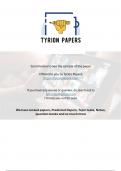Samenvatting
Summary FQM resume for exam (book, clases, ppts)
- Instelling
- Wageningen University (WUR)
Food quality resume of the book and course FQD-20306 of WUR univeristy, preparation for the exam, all subjects and study objectives are addressed in the document.
[Meer zien]










